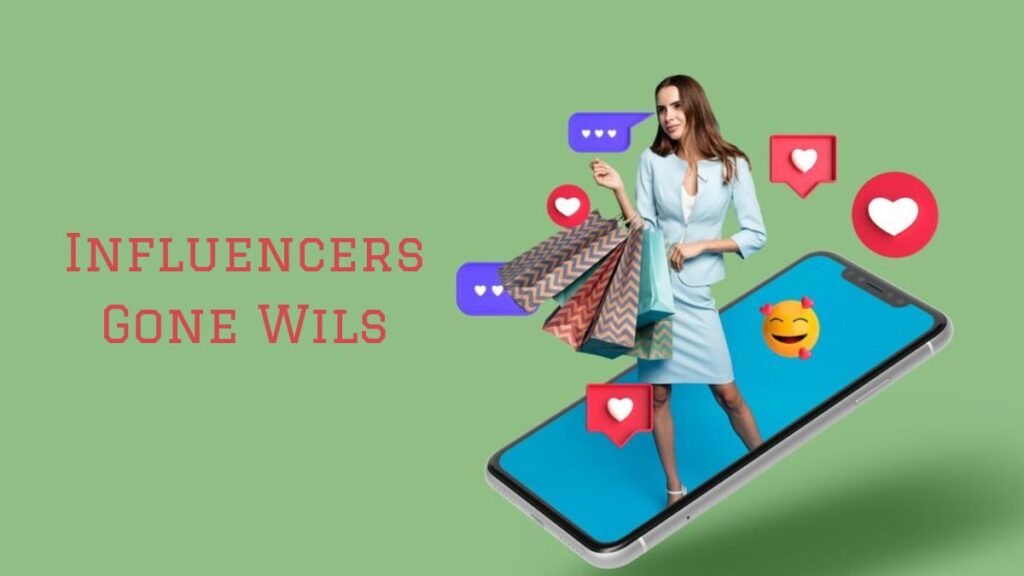Influencers Gone Wils: Influencer culture has exploded in recent years, transforming the way we consume content and interact with brands. Social media platforms like Instagram, TikTok, and YouTube have given rise to a new generation of celebrities who wield immense power over their followers. But as this phenomenon grows, so does the potential for controversy.
From outrageous stunts to inflammatory statements, some influencers are pushing boundaries that leave audiences shocked—and often divided. This trend raises important questions about the nature of authenticity and entertainment in an era where attention is currency. What happens when influencers go wils? How does controversial behavior shape not only their brand but also the social media landscape at large? Let’s delve into this captivating world where likes can come from both admiration and outrage.
Examples of controversial behavior from Influencers Gone Wils
One infamous example is the “Tide Pod Challenge,” where several influencers promoted eating laundry pods for views. This dangerous trend sparked outrage, leading to serious health risks among followers.
Another notable case involves influencers who staged elaborate pranks that blurred ethical lines. These antics often left bystanders bewildered or upset, raising questions about consent and responsibility in content creation.
Then there are instances of influencers flaunting wealth through extravagant displays, like burning cash for attention. Such actions can alienate fans struggling with financial hardships while promoting a culture of excess.
Recently, some have crossed boundaries with insensitive comments during global crises. When tragedy strikes, these posts can feel tone-deaf and dismissive to those suffering.
These behaviors not only attract controversy but also initiate broader discussions on accountability and the impact of social media fame.
The impact of this behavior on their followers and brands
The rise of influencers gone wils has a profound impact on their followers. Many young fans look up to these personalities as role models, emulating their actions and attitudes. When influencers engage in reckless behavior, it can lead to dangerous trends among impressionable audiences.
Brands feel the ripple effects too. Collaborating with controversial figures can tarnish a brand’s image overnight. Consumers increasingly expect brands to align with positive values and social responsibility.
Yet, some brands are drawn to the drama that comes with influencer chaos. The shock value often translates into increased engagement and visibility in crowded markets. This creates a tricky balance for companies torn between ethics and profit.
As this trend continues, both followers and brands must navigate the tumultuous waters of influencer culture carefully. Understanding motivations behind such behaviors is crucial for all parties involved.
The line between authenticity and shock value
Authenticity is the cornerstone of influencer culture. Followers crave genuine connections and real experiences. Yet, what happens when that authenticity starts to blur with shock value?
Some influencers push boundaries to garner attention. They believe outrageous stunts will keep their audience engaged. But this often leads to a disconnect between who they are and what they portray online.
Shock tactics can create a fleeting buzz, but at what cost? Fans may feel misled or manipulated when the facade crumbles. Trust takes time to build, yet moments of controversy can erode it in seconds.
Navigating this fine line is tricky for many creators. Staying true while seeking visibility presents an ongoing challenge. It’s essential for influencers to remember their core values amidst the noise of social media hype.
Why this trend is becoming more prevalent
The rise of influencers gone wils can be linked to the increasing pressure for engagement. Platforms are designed to reward shocking content with higher visibility. Creators often feel compelled to push boundaries.
Another factor is audience desensitization. As followers scroll through countless posts, they crave something different. Outrageous behavior stands out in a crowded feed, ensuring attention.
Moreover, many influencers chase virality over authenticity. The desire for quick fame can lead them to engage in extreme antics that might not align with their true selves.
Societal shifts have made controversial topics more mainstream. Issues once considered taboo are now widely discussed online, prompting influencers to tap into these conversations—even if it means diving headfirst into chaos.
How brands are responding to controversial influencers
Brands are navigating a tricky landscape when it comes to controversial influencers. While some see the potential for increased visibility, others tread carefully due to reputational risks.
Many brands choose to distance themselves from influencers whose behavior sparks outrage. This proactive approach helps them maintain their values and align with customer expectations.
On the other hand, some companies embrace controversy as a marketing strategy. They believe that associating with polarizing figures can increase engagement and drive discussions around their products.
In response, many advertisers are refining their vetting processes. They are scrutinizing influencer backgrounds more than ever before.
Transparency is becoming crucial as brands seek creators who genuinely reflect their ethos while still appealing to diverse audiences. Balancing authenticity with caution has become the name of the game in this evolving relationship between brands and influencers gone wils.
The responsibility of influencers in shaping online culture
Influencers wield significant power in shaping online culture. Their reach can often surpass traditional media, making their words and actions highly impactful.
With millions of followers hanging on their every post, influencers have a responsibility to consider the messages they convey. Every choice they make—from fashion endorsements to lifestyle portrayals—can influence social norms and expectations.
When an influencer goes viral for controversial behavior, it sends ripples through their audience. Young fans may perceive outrageous acts as acceptable or trendy, sometimes leading to misguided ideals.
The pressure to maintain relevance can tempt influencers into shock tactics. However, this short-lived attention comes at a cost—not just for them but also for society’s values.
It’s crucial that influencers recognize their role as cultural architects. They should strive for authenticity without sacrificing integrity or promoting harmful behaviors.
Tips for being a responsible influencer
Being a responsible influencer starts with authenticity. Share your true self, not just a curated image. Your followers appreciate genuine moments.
Engage with your audience thoughtfully. Respond to comments and messages. Show that you value their opinions and feelings.
Transparency is key in collaborations. Always disclose partnerships clearly to maintain trust. Followers deserve to know when you’re promoting something for compensation.
Promote positivity and inclusivity in your content. Highlight diverse voices and experiences, fostering a sense of belonging among your followers.
Remember the impact of your words and actions online. Think before you post; what message are you sending? Be mindful of how it may affect others, especially younger audiences who look up to you as a role model.
Stay grounded amid the chaos of viral trends by prioritizing integrity over shock value.
Conclusion: the future of influencer culture and social media
As we look ahead, the future of influencer culture and social media remains uncertain. The rise of controversial behavior has sparked a debate about authenticity versus shock value. Will influencers continue to push boundaries for fame? Or will they find a balance that respects their audience?
Brands are becoming more discerning in their partnerships. They weigh the risks associated with collaborating with individuals who engage in reckless behavior online. This shift could lead to healthier relationships between brands and influencers.
Moreover, as audiences become more aware, there may be an increasing demand for responsible content creation. Influencers have a unique power to shape conversations and influence behaviors among their followers. With great power comes great responsibility.
The trend of “influencers gone wils” serves as both a cautionary tale and an opportunity for growth within this ever-evolving digital landscape. It encourages all involved—brands, influencers, and followers—to reflect critically on what they consume and promote online.
The direction influencer culture takes depends on collective choices made today by creators, companies, and consumers alike.






